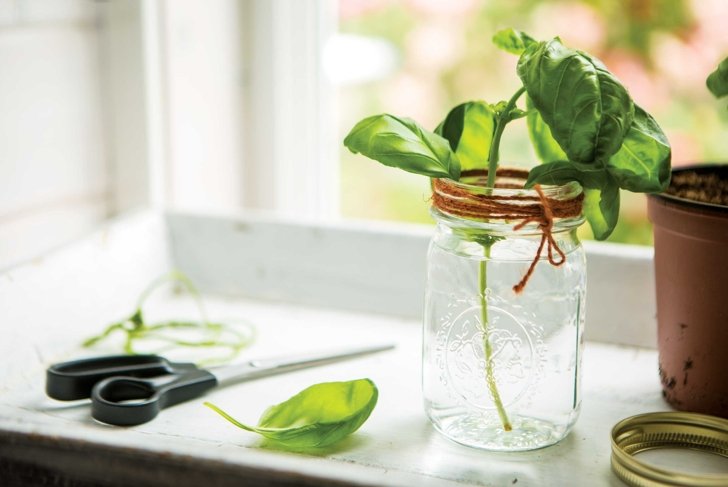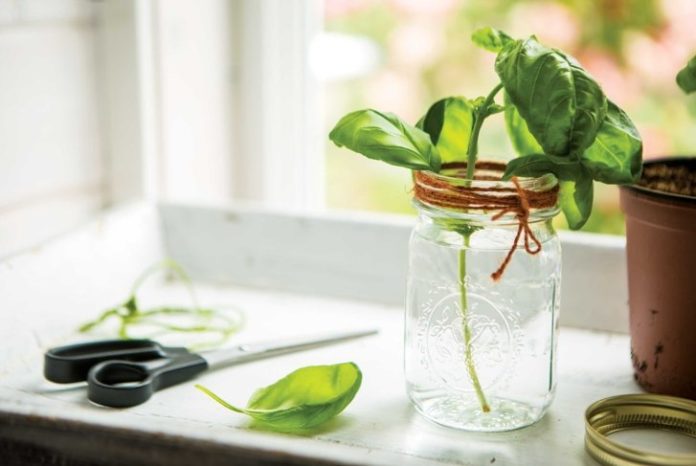
Few foods scream summer like freshly picked basil. Learn how to keep plenty of basil on hand all season long so you can put it to creative culinary uses in the kitchen.
What would the flip-flop wearing, lazy days of summer be without basil? Fairly ho-hum, if you ask me. Basil’s refreshing aroma and distinct flavour make it a cherished addition to a wide range of seasonal dishes from soups to salads to cocktails.
But this benevolent herb is so much more than a culinary wizard. Basil’s also packed with plenty of nutritional highlights to help keep you in tip-top shape all season long. So if your basil plants are exploding in your garden (and that’s a good problem to have), try these recipes. They prove that this lively herb should be used for so much more than a simple garnish.
Handle with care
If you don’t grow your own, purchase basil with lively, vibrant-looking leaves with no dark spots or signs of decay.
Herbal bouquet
Refrigeration can encourage the greens to turn black. Once home, the best way to keep fresh basil fresh is to trim the stems as you would roses, place them in a jar of cold water, and leave at room temperature away from direct sunlight. If you change the water daily, basil should stay fresh for at least five days. Besides, a bouquet of fresh cut basil makes your kitchen feel particularly summery.
Basil’s sweet health benefits
Beyond adding punchy flavour to your daily cooking, basil’s highly fragrant leaves also have some notable health benefits.
Fight diabetes
As with other greens, basil is a good source of vitamin K. Research suggests that a higher intake of this nutrient helps reduce the risk of developing diabetes. In fact, getting enough vitamin K can cut the mortality risk from chronic diseases such as cancer and heart disease.
Power up
A number of studies have uncovered an array of potent flavonoid antioxidants in basil. Antioxidants roam the body looking for cell-damaging free radicals to mop up. In doing so, they exert antiaging properties by lowering inflammation in the body and offering protection from various maladies such as cancer.
Banish bacteria
In addition to its antioxidant might, basil also harbours volatile oils such as eugenol and linalool that appear to have strong antibacterial powers. They could keep down levels of unwanted bacteria in the body for better overall health. And when mixed in with meat-based dishes, there’s also the potential for the bacteria-busting oils in basil to make foods such as chicken and ground meat safer to eat. So for your next backyard cookout make sure to keep bunches of the green herb nearby.
Stay positive
Including basil in your diet more often may help you look on the bright side. In a Harvard study, people with higher levels of carotenoids in the blood, such as those abundant in basil, were more likely to have an optimistic attitude. Research also suggests that greater intakes of beta carotene may help fend off coronary woes by improving cholesterol numbers.
Lower the pressure
An often overlooked benefit of using herbs such as basil in cooking is that they add salt-free flavour. This is important for those who are sensitive to sodium and can experience rises in blood pressure in response to overuse of the salt shaker.
Play the field
To expand the range of tastes on your summer menu, grow various varieties of basil. There are dozens to choose from, each with their own nuanced flavours. Keep an eye out for these at farmers’ markets:
- lemon basil (think seafood dishes and salads)
- classic Genovese basil
- purple hued opal basil (hello, antioxidants)
- pungent holy basil
- spicy cinnamon basil (yum, desserts)
- Thai basil (with its signature anise flavour)
- micro basil (add a fanciful garnish to sandwiches and soups)
Tip: Purple basil is rich in disease-thwarting antioxidants called anthocyanins, the same compounds found in foods such as blueberries and red cabbage.
Recipes
- Lemony Basil Chicken Crepes with Curry Sauce
- Quinoa Salmon Panzanella Salad with Basil Vinaigrette
- Basil White Bean Toasts with Balsamic Syrup
- Basil Avocado Smoothie Packs
- Beet Gazpacho with Basil Cream
Grow your own
Nothing screams summer like a lively bunch of basil growing in your garden. Just keep in mind that basil is cold sensitive, so only plant it after the risk of frost has subsided. It’s easiest to grow basil from seedlings (many farmers’ markets carry several varieties of organic baby plants) that are planted 12 to 16 in (30 to 40 cm) apart.
Planting
Basil will benefit from being placed in rich, well-draining soil with 6 to 8 hours of daily sun exposure. For best results, be sure to incorporate organic compost into the soil when planting and every couple of weeks thereafter. Also consider planting them in the same rows as tomato plants, as they are excellent companions not only in the kitchen but also in the garden. Don’t allow the soil to get too dry, or growth may be stunted.
Picking
For optimal flavour, the leaves should be picked before the plant begins to flower. Pinch leaves from the tips of the stems as this will encourage the plant to keep on sprouting more leaves all season long. Regularly harvesting basil also discourages it from flowering. Once there’s a risk of the first fall frost, go ahead and harvest all of the remaining basil from your garden.
Potting
For home cooks who don’t have access to a garden, basil grows very well in pots. And a pot of lively basil looks lovely on your patio or porch. If planting in a container, use fairly large pots to prevent the plants from drying out quickly in sultry weather. You can also keep basil growing year-round indoors in a sunny window. Have the fresh herb at your fingertips instead of making a trip to the supermarket.
Frozen Asset
Option 1
If you have more basil on your hands than you can use in a reasonable amount of time, consider freezing extras. Simply blanch whole leaves in boiling water for a few seconds, plunge into ice water, pat dry, and place in an airtight container for storage in the freezer.
This basil won’t be great for salads, but it can still punch up the flavour of soups, sauces, and even smoothies. The flavour will be more pronounced if you don’t thaw before using.
Option 2
Place chopped fresh leaves in an ice cube tray and cover with water, oil, or broth before freezing. Once frozen, pop the cubes out into an airtight container. The basil cubes can then be added directly to dishes.
See how it’s done: go to alive.com/video or Instagram @alivehealth










